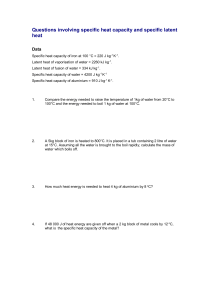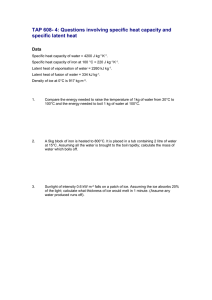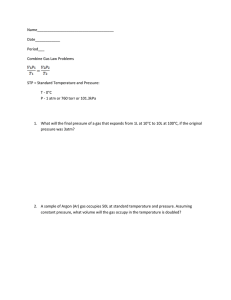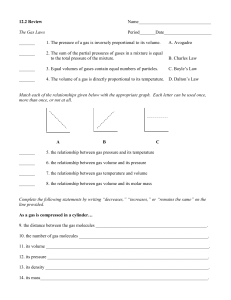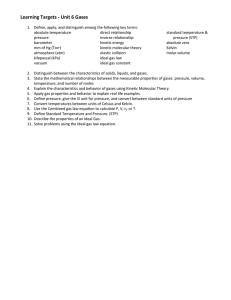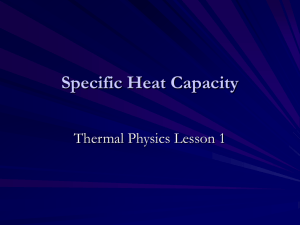Introductory Physics II Test - Thermodynamics & Heat Transfer
advertisement
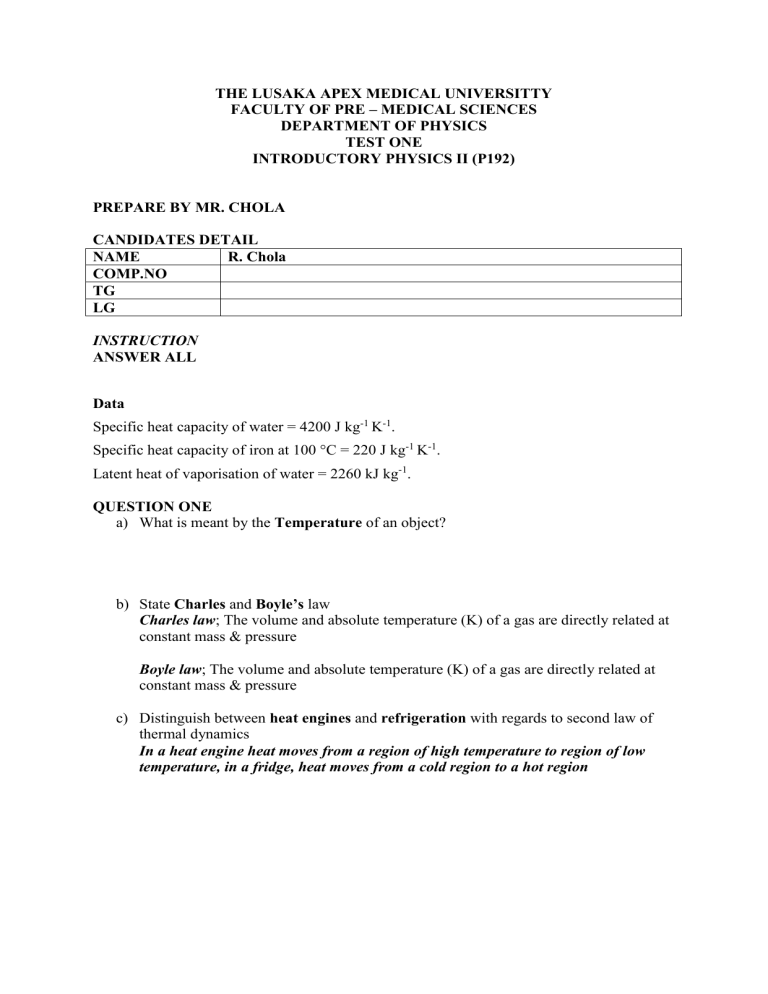
THE LUSAKA APEX MEDICAL UNIVERSITTY FACULTY OF PRE – MEDICAL SCIENCES DEPARTMENT OF PHYSICS TEST ONE INTRODUCTORY PHYSICS II (P192) PREPARE BY MR. CHOLA CANDIDATES DETAIL NAME R. Chola COMP.NO TG LG INSTRUCTION ANSWER ALL Data Specific heat capacity of water = 4200 J kg-1 K-1. Specific heat capacity of iron at 100 °C = 220 J kg-1 K-1. Latent heat of vaporisation of water = 2260 kJ kg-1. QUESTION ONE a) What is meant by the Temperature of an object? b) State Charles and Boyle’s law Charles law; The volume and absolute temperature (K) of a gas are directly related at constant mass & pressure Boyle law; The volume and absolute temperature (K) of a gas are directly related at constant mass & pressure c) Distinguish between heat engines and refrigeration with regards to second law of thermal dynamics In a heat engine heat moves from a region of high temperature to region of low temperature, in a fridge, heat moves from a cold region to a hot region d) Derive the ideal gas equation A general derivation of the ideal gas equation with the help of gas laws is discussed below: Boyle’s Law states that for a fixed number of moles of a gas the volume of a gas varies inversely with its pressure at a constant temperature V ∝ 1/P ————— (1) Where, V= volume P = pressure According to the Charles’ Law, at constant pressure, the volume of a fixed mass of a gas is directly proportional to its absolute temperature. V ∝ T — ———————- (2) Where, T= temperature According to the Avogadro’s Law, at same temperature and pressure, an equal volume of gases contain an equal number of molecules. V ∝ n ———————— (3) Where, n = number of moles of gases From equation (1), (2) and (3), we can deduce that, V ∝ nT/P ⇒ V = RnT/P Pv=nRT Where R is known as a universal gas constant. The above equation is commonly known as an ideal gas equation. Value of R can be calculated at STP (standard temperature pressure) for one mol of gas as: Volume at STP = 22.710981 L/mol Pressure at STP = 1 bar = 105 Pa Temperature at STP = 273.15 R = 22.710981 × 105273.15 = 8.314JK−1mol−1 e) Compare the energy needed to raise the temperature of 1kg of water from 20°C to 100°C and the energy needed to boil 1 kg of water at 100°C. ANSWER Energy required to heat the water = mCθ = 1 4200 80 = 336 kJ Energy required to boil the water = mL = 1 2260 kJ = 2260kJ. So it takes nearly 7 times as much energy to boil the water as to heat it up. QUESTION TWO An unknown metal decreases in length from 9.36m to 9.22 m. This change happened when the temperature fell from 36.2°C to -3.2o C. what is the coefficient of linear expansion? 380*10-6 QUESTION THREE Mark the statements you consider TRUE [4 MARKS] SUBTRACT 1 FOR WRONG ANSWER 1. Entropy is a scalar quantity. TRUE 2. Heat cannot flow from colder objects to hotter ones. FALSE 3. The first law of thermodynamics is a special case of the second law of thermodynamics. FALSE 4. Gases are more disordered systems than solids. TRUE A copper bar, of length 10cm width 9mm and thickness 3mm has a thermal conductivity 400 Wm-1K-1. This is connected between two objects whose temperatures differ by 60oC. Calculate the rate of heat flowing through the bar. 6.48 Wm-1K-1 QUESTION FOUR A refrigerator with C.O.P. = 4.7, extracts heat from the inside at a rate of 250 J per cycle. (a) How much work per cycle is required to operate the refrigerator? (b) How much heat per cycle is discharged into the room? 53 J, 303 J 53.2 + 250
